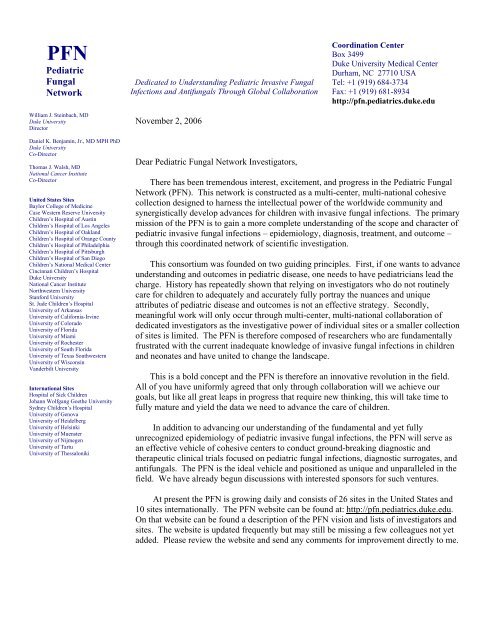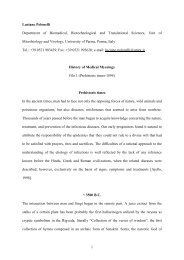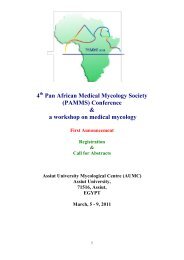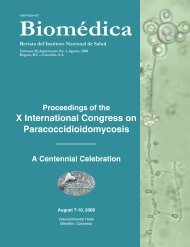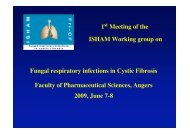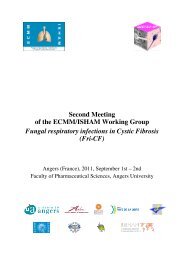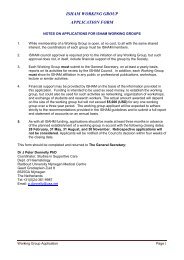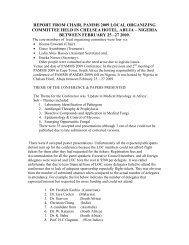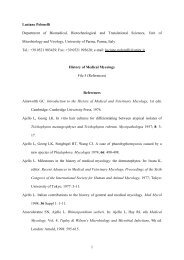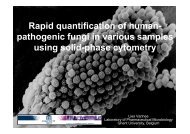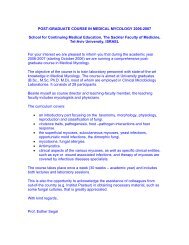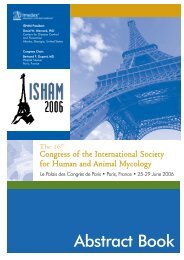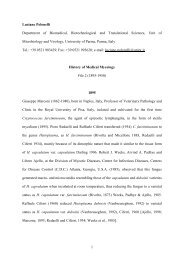Pediatric Fungal Network - ISHAM
Pediatric Fungal Network - ISHAM
Pediatric Fungal Network - ISHAM
Create successful ePaper yourself
Turn your PDF publications into a flip-book with our unique Google optimized e-Paper software.
PFN<br />
<strong>Pediatric</strong><br />
<strong>Fungal</strong><br />
<strong>Network</strong><br />
William J. Steinbach, MD<br />
Duke University<br />
Director<br />
Dedicated to Understanding <strong>Pediatric</strong> Invasive <strong>Fungal</strong><br />
Infections and Antifungals Through Global Collaboration<br />
November 2, 2006<br />
Coordination Center<br />
Box 3499<br />
Duke University Medical Center<br />
Durham, NC 27710 USA<br />
Tel: +1 (919) 684-3734<br />
Fax: +1 (919) 681-8934<br />
http://pfn.pediatrics.duke.edu<br />
Daniel K. Benjamin, Jr., MD MPH PhD<br />
Duke University<br />
Co-Director<br />
Thomas J. Walsh, MD<br />
National Cancer Institute<br />
Co-Director<br />
United States Sites<br />
Baylor College of Medicine<br />
Case Western Reserve University<br />
Children’s Hospital of Austin<br />
Children’s Hospital of Los Angeles<br />
Children’s Hospital of Oakland<br />
Children’s Hospital of Orange County<br />
Children’s Hospital of Philadelphia<br />
Children’s Hospital of Pittsburgh<br />
Children’s Hospital of San Diego<br />
Children’s National Medical Center<br />
Cincinnati Children’s Hospital<br />
Duke University<br />
National Cancer Institute<br />
Northwestern University<br />
Stanford University<br />
St. Jude Children’s Hospital<br />
University of Arkansas<br />
University of California-Irvine<br />
University of Colorado<br />
University of Florida<br />
University of Miami<br />
University of Rochester<br />
University of South Florida<br />
University of Texas Southwestern<br />
University of Wisconsin<br />
Vanderbilt University<br />
International Sites<br />
Hospital of Sick Children<br />
Johann Wolfgang Goethe University<br />
Sydney Children’s Hospital<br />
University of Genova<br />
University of Heidelberg<br />
University of Helsinki<br />
University of Muenster<br />
University of Nijmegen<br />
University of Tartu<br />
University of Thessaloniki<br />
Dear <strong>Pediatric</strong> <strong>Fungal</strong> <strong>Network</strong> Investigators,<br />
There has been tremendous interest, excitement, and progress in the <strong>Pediatric</strong> <strong>Fungal</strong><br />
<strong>Network</strong> (PFN). This network is constructed as a multi-center, multi-national cohesive<br />
collection designed to harness the intellectual power of the worldwide community and<br />
synergistically develop advances for children with invasive fungal infections. The primary<br />
mission of the PFN is to gain a more complete understanding of the scope and character of<br />
pediatric invasive fungal infections – epidemiology, diagnosis, treatment, and outcome –<br />
through this coordinated network of scientific investigation.<br />
This consortium was founded on two guiding principles. First, if one wants to advance<br />
understanding and outcomes in pediatric disease, one needs to have pediatricians lead the<br />
charge. History has repeatedly shown that relying on investigators who do not routinely<br />
care for children to adequately and accurately fully portray the nuances and unique<br />
attributes of pediatric disease and outcomes is not an effective strategy. Secondly,<br />
meaningful work will only occur through multi-center, multi-national collaboration of<br />
dedicated investigators as the investigative power of individual sites or a smaller collection<br />
of sites is limited. The PFN is therefore composed of researchers who are fundamentally<br />
frustrated with the current inadequate knowledge of invasive fungal infections in children<br />
and neonates and have united to change the landscape.<br />
This is a bold concept and the PFN is therefore an innovative revolution in the field.<br />
All of you have uniformly agreed that only through collaboration will we achieve our<br />
goals, but like all great leaps in progress that require new thinking, this will take time to<br />
fully mature and yield the data we need to advance the care of children.<br />
In addition to advancing our understanding of the fundamental and yet fully<br />
unrecognized epidemiology of pediatric invasive fungal infections, the PFN will serve as<br />
an effective vehicle of cohesive centers to conduct ground-breaking diagnostic and<br />
therapeutic clinical trials focused on pediatric fungal infections, diagnostic surrogates, and<br />
antifungals. The PFN is the ideal vehicle and positioned as unique and unparalleled in the<br />
field. We have already begun discussions with interested sponsors for such ventures.<br />
At present the PFN is growing daily and consists of 26 sites in the United States and<br />
10 sites internationally. The PFN website can be found at: http://pfn.pediatrics.duke.edu.<br />
On that website can be found a description of the PFN vision and lists of investigators and<br />
sites. The website is updated frequently but may still be missing a few colleagues not yet<br />
added. Please review the website and send any comments for improvement directly to me.
Investigators<br />
2 November 2006<br />
Page 2<br />
Additionally, if you know of interested colleagues at other centers who are interested in joining the<br />
group, please have them email me. The website will also be the location for entry of clinical data through<br />
an electronic CRF (eCRF) format. This capability is not easily evident now on the website, but the<br />
infrastructure has already been designed. In the future you all will acquire usernames and passwords for<br />
access to the data entry aspects.<br />
It was thought that the first projects for such a new network should focus on gathering fundamental<br />
epidemiologic information, for only through accurate collection of this data will we be positioned to<br />
effectively design the future clinical trials in the field. In order to start smaller and allow room for<br />
growth, we think infections with both Candida and Aspergillus would capture most of the relevant<br />
patients. We have constructed steering committees for the two types of infections, and the chairman for<br />
the Candida group is Theo Zaoutis (Children’s Hospital of Philadelphia) and for the Aspergillus group it<br />
is Bill Steinbach (Duke University). The steering committees for each project are charged to develop an<br />
effective, concise (likely 3 pages maximum), eCRF to capture the data. Based on previous known<br />
interests we have selected several individuals from the PFN to sit on those committees, but please email<br />
the two chairs if you are also interested in participating in the eCRF development phase. The studies<br />
themselves will begin after eCRF development. Many of the involved investigators and sites have<br />
clinical research coordinators who are working on other related projects who are able to enter in the data<br />
for an additional eCRF for these studies. For those sites without such a resource, a concise and simple<br />
eCRF will be quite beneficial. There will also likely be the requirement for IRB approval at many<br />
centers for a prospective observational epidemiologic study, and we will send an already approved IRB<br />
template to all of you for use in drafting your own institution’s IRB documents.<br />
As mentioned earlier, at present the PFN does not have the funding to pay investigators or sites on a<br />
per-patient recruitment basis. This work is being done by all of us for the chance to dramatically alter the<br />
field in a novel fashion as well as the many opportunities for analysis and publication of the data. The<br />
data we accumulate will be unprecedented in scope and will be spread around the interested investigators<br />
who want to analyze aspects of it for publication. In the future we will devise a publication scheme so<br />
the data is optimally used by all. Initial funding has been secured for the website and administrative tasks<br />
(future conference calls, mailings, etc). I have also successfully gathered additional funding promises<br />
from other companies and am currently lobbying other organizations (foundations, CDC, NIH, etc.) for<br />
additional assistance. To date this consortium has been very well-received by all.<br />
The PFN will operate as a democracy of colleagues who all have common goals. Future conference<br />
calls will be scheduled for the current and future working groups and we invite all comments and<br />
thoughts on how to best achieve our goals.<br />
Sincerely,<br />
Bill Steinbach<br />
On behalf of the <strong>Pediatric</strong> <strong>Fungal</strong> <strong>Network</strong>


